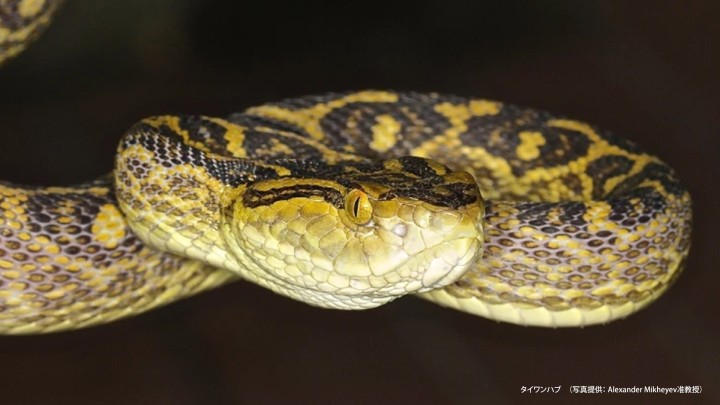Following evolutions wayward path

The latest OIST column in the Asahi Shimbun GLOBE+ is out now! The article is in Japanese, but the original English translation is given below.
Following evolutions wayward path
Snake venom provides a useful model for unravelling the mysteries of evolution, says PhD student Agneesh Barua.
Over billions of years, life on Earth has evolved to fill nearly every niche available. Evolution is responsible for the incredible diversity that we see around the world – from single celled plankton to plants, reptiles, and mammals. In many ways it might seem to be following a fixed path, leading from simple to complex organisms, but one PhD student at the Okinawa Institute of Science and Technology Graduate University argues that this is anything but the case.
“Over many generations, organisms will change and evolve but there’s no pre-determined direction that they’re going,” explained Agneesh Barua, who researches the evolution of snake venom. “In fact, the direction keeps changing.”
Caption: PhD student Agneesh Barua on the OIST campus.
Before arriving at OIST, Agneesh completed a Master’s in genetics at the University of Calcutta in India, where he looked at therapies for brain cancer, but his fascination with evolution and ecology eventually drew him to pursue a PhD in a lab that specializes in these areas.
“Nature has these common building blocks,” Agneesh tells me. “There are just four bases – A, T, G, and C – that make up the DNA of all living creatures. But, despite this, life has evolved into these incredibly diverse forms. I’m interested in how nature did this – how it played around with different genes to produce different characteristics. There’s something elegant about it.”
Agneesh describes snake venom as a cocktail of different toxin proteins. What makes it ideal as a model for this research is that it’s easy to trace each toxin to the specific gene that’s responsible for it. It’s a useful characteristic that allows one to look for genetic patterns which would be hard to find elsewhere in nature. He’s particularly interested in how genes impact characteristics, and how they change and evolve through time.
Agneesh with his supervisor Professor Alexander Mikheyev (left).
We’re speaking on the OIST campus, which overlooks the Okinawan jungle. It’s a dense, sub-tropical rainforest that’s home to many unique and unusual species. On my walk to work each morning, I pass signs warning me about the venomous habu snakes that are common on this island. It seems like the perfect place to be out and about looking for these reptiles, but Agneesh actually spends most of his time running computer models.
Going from experimental cancer biology, to computer programming might seem like a leap but Agneesh has generally found the ecology and evolution community to be very tech savvy and helpful.
“When I arrived at OIST in 2016, the lab I was in already had a lot of data on snake venom, and I collected more at the start of my PhD. In total, we looked at over 50 species from around the world. I’ve fitted a series of models to this data to test a variety of different scenarios to determine how snake venom evolved. I wouldn’t have been exposed to this kind of research if I had stayed in biomedical science. I learnt how to do the programming by myself, which was slow but rewarding.”
This research is grounded in the never-ending, evolutionary race between predators and prey. Prey evolve ways to avoid predators. In turn, predators must evolve more sophisticated ways to catch their prey, and snakes are no different. Their venom is primarily used to capture food, through killing or immobilizing their prey.
Oral venom likely traces back to around 300 million years ago. The system started as a common blueprint shared by the ancestor of snakes. Over time, snakes diversified and spread across the globe, which resulted in them living in different environments, hunting different prey, and thus experimenting with different cocktails of venom. One aspect that Agneesh has been looking at is whether the diversification of venom has driven the diversification of snakes.
“We found that snake venom evolved constantly, which makes sense because snakes are in a constant evolutionary arms race with their prey. There have also been periods of rapid change in the amount of toxin snakes produce in their venom, which could open up new opportunities for catching their prey.”
Interestingly, however, this research showed that although the venom was diversifying, this did not necessarily lead to new species of snakes.
“There are certain traits which scientists think are more important to bring about differences between animals, and these traits eventually lead to new species,” explained Agneesh.
These traits are called key innovations and they result in the formation of new species by increasing a population’s fitness or allowing individuals to occupy new environments. A classic example can be found in your teeth – the evolution of the fourth cusp of molars meant that the ancestors of mammals could chew effectively and thus consume a generalized diet through breaking down plants.
“We thought that snake venom might also cause diversification. But our research has shown that this might not be the case. Snake venom has allowed snakes to change their environments and prey but that doesn’t mean they become new species as they aren’t necessarily isolated from one another.”
Although this might be a surprising result, Agneesh emphasized that if there’s one thing that his research has shown him, it’s that nature doesn’t have a grand plan. “Evolution isn’t leading to anything,” he said and with this, he explained, comes a warning. “As humans, we’re aware of how we’re changing nature – with actions that cause climate change, ocean acidification, and biodiversity loss – and it’s up to us to fix because nature won’t do it for us.”
A recent paper published on this research was recommended by members of the National Academy of Science, which highlights how important it is for the fundamental understanding of evolution. Furthermore, today, many scientists are looking at how to manipulate genes. Editing genes could lead to more viable crops in a changing climate or help keep pests at bay. And Agneesh argues that if we want to do this then we first need to understand how nature has been manipulating these systems.
Caption: Agneesh and the author Lucy Dickie discuss the snake venom research.














